New products at Crocus
by Sarah - June 25th, 2010.Filed under: Crocus, New Products.
New products at Crocus

hotspot-patio-brazier-with-safety-cover £69.99
You’ll enjoy real fire warmth when entertaining outside with this dual-purpose, durable, steel brazier. Ideal for burning logs, it comes complete with a spark guard, ash collector and a hinged grill so that you can cook on it too. Size: 65x75cm wide
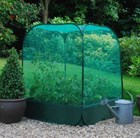
pop-up-net-cover-for-grow-bed £29.99
This 1.2 metre high net enclosure features 6mm mesh to protect against birds, rabbits and larger insects. The cover springs into shape, thanks to the zinc wire frame, negating the need for assembly. Supplied with 8 metal anchor stakes Can be used independently of grow bed if required. Length: 98cm Width 98cm Height 120cm
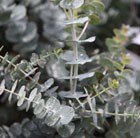
gum tree £19.99
Position: full sunSoil: neutral to slightly acidic soil that doesn’t dry outRate of growth: fast-growingFlowering period: July to OctoberFlower colour: white to cream, but not often seen in BritainOther features: usually grown with multiple stems as it seemsto cope with strong winds betterHardiness: borderline hardy (will need protection in winter)A new and exciting introduction, this beautiful tree is primarily grown for its decorative foliage. When the tree is young, the leaves are rounded and a steely blue-grey, but as the plant matures the leaves become sickle-shaped and look greener. Both types of leaves will emit a delicious peppermint-like scent when bruised. It is not fully hardy here in the UK, but will thrive in warmer, sheltered gardens, especially where the soils do not hold too much moisture in winter, and there is protection from icy winds. This versatile plant can be pollarded each year to maintain a shrubby shape, which will ensure a continuous supply of juvenile foliage (it is great added to cut flower arrangements), or leave it unpruned and it will form a single-stemmed tree with glorious pink and white flushed, peeling bark.Garden care: Requires minimal pruning if grown as a tree, removing any broken, diseased or crossing branches in late autumn or winter. For the best juvenile foliage, prune in early spring cutting back the stems to two or three buds above the base. When planting incorporate lots of well-rotted garden compost in the planting hole and stake firmly.

bamboo £19.99
Position: full sun or partial shadeSoil: humus-rich, moist, well-drained soilRate of growth: fast growingLeaves: mid-greenCanes: dark green, sometimes stained with purpleHardiness: fully hardyVigorous and hardy, this decorative bamboo is one of the first to produce new canes each year. These canes appear in late spring or early summer and have a mainly upright habit, but do arch slightly. Their colour is green, but will sometimes have a purple flush, but over a period of several years, will fade to a yellow-green. They have a glossy finish and are clothed in rich green leaves, which cope well with adverse weather conditions. Initially forming really dense clumps, this bamboo is ideal for screening, but will spread with age. Garden care: Plant in a large container or surround the roots with a non-perishable barrier that restricts the plant’s spread.
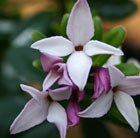
daphne £19.99
Position: full sun or partial shadeSoil: moderately fertile, well-drained, humus-rich soil,Rate of growth: slow-growing Flowering period: May to June Flower colour: white flowers with a purple-red flush outsideOther features: all parts of the plant including the seed are highly toxic if ingested; contact with the sap may cause skin irritationHardiness: fully hardyA compact, evergreen shrub that forms mounds of leathery, dark green foliage, and in late spring and early summer, clusters of white flowers that have a reddish purple flush on the outside. These form at the tips of the branches, have a delicious scent and are followed by rounded red fruits. It is a wonderful plant to include in a mixed border or woodland garden, ideally close to a path or entrance so you can enjoy the scent of the flowers every time you pass.Garden care: Keep pruning to a minimum, but if necessary you can lightly trim it back immediately after flowering. Apply a generous mulch in spring, which will help keep the roots cool.
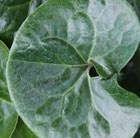
wild ginger £6.99
Position: cool shade or partial shadeSoil: prefers humus-rich soils which do not dry out in summerRate of growth: moderate with good spreading capacityFlowering period: March to April. Most floriferous following a warm summer in the previous yearFlower colour: reddish purpleHardiness: fully hardyRobust and reliable groundcover plants, offering attractive foliage effect in shady places. Asarum europaeum has been valued and cultivated as a medicinal herb since the 13th century and is more tolerant than other varieties of the cooler British summers. These low, spreading plants have sweetly pungent roots which give rise to their common name of ‘hardy ginger’. Exotic hooded purple-red flowers on short stems appear in the spring nestled under glossy rounded leaves.Garden care: A low maintenance plant requiring only a light mulch of leaf mould or garden compost every one or two years to maintain soil fertility.
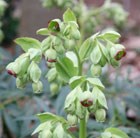
stinking hellebore £6.99
Position: partial shadeSoil: any moist, neutral to alkaline soil, including heavy soilRate of growth: average Flowering period: January to AprilOther features: all parts of the plant cause severe discomfort if ingested; the sap may cause skin irritation; dark greyish-green leaves give off an unpleasant odour when crushedHardiness: fully hardyNodding, bell-shaped, pale green flowers with purple edges appear above clumps of deeply divided dark green leaves from January to April. Our native ‘stinking hellebore’ is aptly named as the leaves give off an unpleasant odour when crushed. This is an unusual, architectural plant for a shady border or woodland garden, or beneath deciduous shrubs, where its evergreen foliage can be shown off in autumn and winter.Garden care: Add lots of well-rotted leaf mould, compost or manure to the planting hole. Apply a generous 5-7cm (2-3in) mulch of well-rotted organic matter around the base of the plant and provide a top-dressing of general fertiliser each spring.
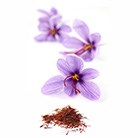
saffron crocus £2.49
Position: full sunSoil: gritty, poor to moderately fertile, well-drained soilRate of growth: averageFlowering period: October and NovemberOther features: slender, strap-shaped, mid-green leavesHardiness: fully hardyGrow your own saffron (the most expensive spice in the world.) Large, open, rich lilac flowers with distinctive purple veins in October and November. This autumn-flowering crocus is named after its three long, deep-red stigmas, which are cultivated commercially for colouring and flavouring food. To provide the conditions in which it thrives plant the bulbs 10-15cm (4-6in) deep in August in gritty, well-drained soil.Garden care: Plant bulbs in naturalistic drifts 10-15cm (4-6in) deep in August in gritty, well-drained soil. Where bulbs are planted in grass do not cut the lawn until after the leaves have died back
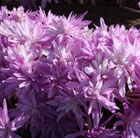
autumn crocus £2.49
Position: full sunSoil: deep, fertile, well-drained soilRate of growth: averageFlowering period: September and OctoberFlower colour: pinkOther features: all parts of the plant are highly toxic if ingested; contact with the skin may cause irritationHardiness: fully hardyDramatic, double pink flowers reminiscent of waterlilies in September and October. followed by large leaves, retained until mid-summer. These autumn-flowering bulbs are perfect for naturalising in grass under a semi-mature specimen tree. Always wear gloves when working with colchicum since all parts of the plant are poisonous and a potential skin irritant.Garden care: Wear gloves to plant bulbs in naturalistic drifts 15cm (6in) deep in July or autumn






